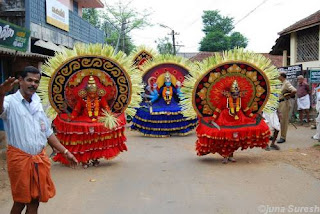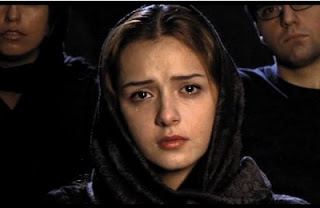

Sree Muthappan is a Hindu deity worshipped commonly in Kannur district of north Kerala state, South India. Muthappan and Thiruvappan, are considered to be a manifestation of Shiva and Vishnu, and hence Muthappan wholly represents the idea of Brahman, the unity of God, as expressed in the Vedas.
Worship of Muthappan is unique, in that it does not follow the Sattvic (Brahminical) form of worship, as in other Hindu temples. The main mode of worship is not via idol worship, but via a ritual enactment of Muthappan, performed daily at the Parassinikadavu temple. Fish is used as an offering to Muthappan, and people of all castes, religions and nationalities are permitted to enter the temple and take part in the worship.
Muthappan is also the principal deity in the ritualistic Theyyam dance (Muthappan Theyyam) performed in the famous Parassinikkadavu temple. The ritual performers of Muthappan Theyyam belong to the tribal community of Kerala. It is unique because in Kerala both the upper-caste Brahmins, and the lower-caste tribals, both have a significant contribution to the major forms of worship.
The traditional story of Parassinikkadavu Muthappan describes the background of the deity.
The Naduvazhi (landlord) Ayyankara Illath Vazhunnavar (a Nambudiri Brahmin) was unhappy, as he had no child. His wife Padikutty Antharjanam was a devotee of Lord Shiva. She made a sacrifice to Shiva for children. One day in her dream she saw the Lord. The very next day, while she was returning after a bath from a near by river, she saw a pretty child lying on a flower bed. She took the child home and she and her husband brought Him up as their own son.
The boy used to visit the jungle near their house (mana) for hunting with His bow and arrows. He would then take food to the poor and to the backward communities with Him. As these acts were against the Namboothiri way of life, His parents earnestly requested Him to stop this practice, but the boy turned a deaf ear to their warnings. Ayyankara Vazhunavar became very disappointed.
One day the boy revealed His divine form (Visvaroopam or Viswaroopa or Cosmic All-Pervading form) to His parents. They then realized that the boy was not an ordinary child but God. They prostrated themselves in front of Him and He blessed them.
He then started a journey from Ayyankara. The natural beauty of Kunnathoor detained Him. He was attracted by the toddy of palm trees.
Chandan (an illiterate and uncivilized toddy tapper) knew that his toddy was being stolen from his palm trees, so he decided to guard his palm trees. While he was keeping guard at night, he caught an old man stealing toddy from his palms. He got very angry and tried to shoot the old man using his bow and arrows but fell unconscious before he could let loose even an arrow.
Chandan's wife came searching for her husband. She cried brokenheartedly when she found him unconscious at the base of the tree. She saw an old man at the top of the palm tree, and called out to Him as "MUTHAPPAN" ("Muthappan" means grandfather in the local Malayalam language). She earnestly prayed to the God to save her husband. Before long, Chandan regained consciousness.
She offered boiled grams, slices of coconut, burnt fish and toddy to the Muthappan (Even today in Sree Muthappan temples the devotees are offered boiled grams and slices of coconut). She sought a blessing from Him. Muthappan chose Kunnathoor as His residence at the request of Chandan. This is the famous Kunnathoor Padi.
After spending some years at Kunnathoor, Sree Muthappan decided to look for a more favorable residence so that He could achieve His objective of His avataram. He shot an arrow upward from Kunnathoor. The shaft reached Parassini where the famous Parassini Temple stands today. The arrow, when it was found, was glowing in the Theertha (sacred water) near the temple. The arrow was placed on the altar of the temple. Since then, Lord Sree Muthappan has been thought to reside at Parassinikkadavu. As a boy, Muthappan was rebellious. He was a great hunter and would skin the animals that He killed and wear their skins as clothes. One day, He came across a coconut tree that was being tapped for toddy, the liquor fermented from coconut sap. He climbed the tree and emptied the jar that was holding the toddy. When the toddy tapper returned and saw Muthappan, he immediately challenged Him. Muthappan turned the man to stone for daring to address such a powerful God as Himself in such a manner. During performances of Muthappan Theyyam, the performer consumes the toddy liquor and passes it around to the spectators. In this act, Muthappan “breaks” the temple rules by allowing alcohol into temple grounds.
Sree Muthappan is always accompanied by a dog. Dogs are considered sacred here and one can see dogs in large numbers in and around the temple.
One can see two carved bronze dogs at the entrance of the temple that are believed to symbolize the bodyguards of the God. When the Prasad is ready it is first served to a dog that is always ready inside the temple complex.
Local legends enhance the importance of dogs to Sree Muthappan, such as the story that follows:
A few years ago, temple authorities decided to reduce the number of dogs inside the temple; so they took some dogs and puppies away. From that very day, the performer of the Sree Muthappan Theyyam was unable to perform; it is said that the spirit of Sree Muthappan enters the performer's body for the duration of the ceremony. But He probably refused to enter the Theyyam performer's body because the dogs had been removed. Realizing their mistake, the dogs were brought back to the temple by the temple authorities. From that day onwards, Theyyam performances returned to normal.
Several Muthappan Temples are seen in different parts of Kannur and Kasaragod districts. This signifies the popularity of the God in the minds of the people of this region of Kerala. Each Madappura has its own tradition. One interesting story relating to God Muthappan is about the Nileshwar Muthappan Madappura. The Sree Muthappan temple near National Highway No 17 in Nileshwar has a rich heritage. It conveys the philosophical, devotional and educational importance of Nileshwar. There is an interesting story regarding the construction of this Sree Muthappan Temple. An elder member of the Koroth family regularly visited the place now known as the Muthappan temple and drank madhu (Toddy), the liquor fermented from coconut sap, a kind of intoxicating drink. He was a famous scholar and got the title Ezhuthachan for his commendable achievement as a teacher. Before drinking madhu, he poured a few drops of madhu on the nearby jackfruit tree as an offering for the God Muthappan. He regularly repeated the practice. Several years after the death of the above mentioned scholar the natives experienced various kinds of serious problems and called upon an astrologer for assistance in finding out the cause behind all this. The astrologer concluded that as a result of the regular practice of giving madhu to God Muthappan, the God had started residing there. After the death of the scholar, He no longer got madhu, and in a fit of pique, began creating disturbances. Then the natives erected a Muthappan temple there. The Koroth Family then got the right of Koymma [patron] in the temple.
As a result of the formation of a committee and the work done by the members of the committee the temple has developed as a famous centre of pilgrimage and hundreds of people visited it daily. There is a strong belief that the God will cure all diseases and will bestow prosperity on His devotees. The devotees get Payakutti from the temple; and it continues to develop as a great centre of pilgrimage like the Sree Muthappan temple at Parassinikadavu.












